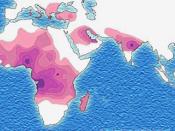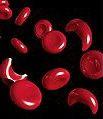Cystic Fibrosis is a disease common among people with European ancestry. People with the disease do not usually survive into their twenties. Cystic Fibrosis is autosomal recessive. Symptoms related to the disease are difficulty breathing, mucous production in the respiratory and digestive systems, and several infections.
Tay-Sach's disease destroys the nervous system. It is common among Jewish Europeans. The inheritance pattern for Tay-Sachs is autosomal recessive. Most people with this disease die at a very early age.
Huntington disease is an autosomal dominant disease. No symptoms are shown until people reach their thirties or forties. By this time the disease has been passed on to their offspring without knowledge. Huntington disease damages the nervous system. People with Huntington disease suffer painful, progressive loss of muscle control and mental function until death occurs.
Sickle Cell Anemia is caused by a change in the polypeptides found in hemoglobin, the protein that carries oxygen in red blood cells.
When a person with this disease is deprived of oxygen the hemoglobin molecules join together and form fibers, which cause the red blood cells to bend and twist. The bent and twisted blood cells then get stuck in capillaries and the blood flow is stopped and cells are damaged. The result of this may be serious injury or death. Sickle Cell Anemia is autosomal codominant, with (A) being normal and (S) being sickle cell anemia. A carrier of the disease is (AS) and a sufferer is (SS). Some symptoms of Sickle Cell Anemia are weakness, dizzy spells, and open sores. In the United States it is most common among people of African Ancestry, throughout the world the disease is common in tropical regions of Africa and Asia. It has been discovered that Sickle Cell Anemia persists wherever carriers of the disease have survived Malaria.
Colorblindness is a disorder in which the genes for colorblindness render some people unable to make some of the pigments in the eye necessary for color vision. It is an X-linked recessive trait. The most common type is red-green colorblindness. In Caucasians 8% of males, and 1% of females are affected by this type of colorblindness.
Hemophilia, or "bleeders disease" is an X-linked recessive disease. Hemophilia is a disorder in which the protein antihemophilic factor (AHF), that is necessary for normal blood clotting, is missing. Hemophilia only affects 1 in 10,000 males and 1 in 100,000,000 females but it is very serious. Someone with Hemophilia can bleed to death from even a tiny cut and internal bleeding, or hemorrhaging, may occur from just the slightest bump, or bruise. Removing the AFH from donated blood and injecting it into an affected person's blood can provide treatment, but this procedure is inconvenient and dangerous.
Muscular Dystrophy is an inherited disease resulting in the wasting away of skeletal muscle. It is X-linked recessive. People who develop Muscular Dystrophy as a child rarely survive past early adulthood.
Turner Syndrome is a disorder that results in a person who is female in appearance but their sex organs do not develop during puberty and they become sterile. It is abbreviated by 45X or 45XO, meaning the second sex chromosome is absent. Turner Syndrome has an X-linked nondisjunction inheritance pattern
Klinefelter Syndrome is a disorder that affects people by giving them an extra sex chromosome. It is X-linked nondisjunction and abbreviated by 47XXY. People with Klinefelter Syndrome are male in appearance but during puberty their sex organs do not develop and they become sterile.
Down Syndrome, also called Trisomy 21, occurs when there is a copy of chromosome 21. It is autosomal nondisjunction. In the United States 1 baby in every 800 is born with Down syndrome. It results in mental retardation ranging from mild to severe. People with Down syndrome have an increased susceptibility to many diseases. In rare cases there are the normal 46 chromosomes but a small portion of chromosome 21 is attached to another chromosome.



Nice but a lot of Jargon
It is good but has a lot of Jargon that is not easy to understand, however it is good writing for a 10th grader.
1 out of 1 people found this comment useful.